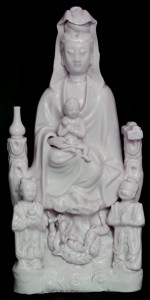Dehua Kilns Maria Kannon マリア観音
(c. 17 Century)
Porcelain Statue
This statue was seized in Uragami, Nagasaki Prefecture,in 1856, Ming-Qing dynasty, 17th century. It was then preserved by the Nagasaki Magistrate’s Office. Currently the statue is kept safely in Tokyo National Museum.
It depict the feminine form of Koyasu Kannon (子安観音), the god that represent birth and child rearing. Despite bearing the resemblance of “Byakue Kannon”, she holds a child in her hand. To the Christians the statue resembles Virgin Mary and Baby Jesus. The white robe, according to Christianity, represents purity and righteousness. It also symbolizes salvation.
During the mid-17th century, outlawed Christians created statues of Virgin Mary (Mother of Jesus) disguised as the Buddhist deity Kannon (Goddess of Mercy, Guanyin). These statues are known as Maria Kannon. Maria Kannon was made or altered to look like Kannon (Goddess of Mercy), however they were not worshipped as Kannon. This act of concealment allowed the Christian to practice their faith in secret, minimizing the chance of being exposed. Since their faith were forced to go underground, the follower usual practice their faith in a hidden room, a cave or in a forest.
There are a number of Maria Kannon statues, which includes “Byakue Kannon”, “Jibo Kannon”, Guanyin (Kannon) and Child of many different sizes. Some of which even include hidden image of the “cross” within them and some have it at the back of the statue. With the presence of the cross within the statue it indirectly imply that the statue is in fact constructed for Christian and not Buddhist despite it resembling Buddhist deity Kannon. The Christians would honor this statue by silently praying to Mother Mary. With such “trick” it creates a sense of relief for the follower. To the outsider it appears as a Buddhist statue but to the outlawed Christian, it appears as an object of Christ faith. Which successfully also fooled the government and help them to keep their faith hidden and alive.
Image: https://upload.wikimedia.org/wikipedia/commons/3/36/Maria_Kannon.jpg
